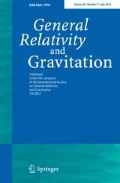Abstract
The entropy principle shows that, for self-gravitating perfect fluid, the Einstein field equations can be derived from the extrema of the total entropy, and the thermodynamical stability criterion are equivalent to the dynamical stability criterion. In this paper, we recast the dynamical criterion for the charged self-gravitating perfect fluid in Einstein–Maxwell theory, and further give the criterion of the star with barotropic condition. In order to obtain the thermodynamical stability criterion, first we get the general formula of the second variation of the total entropy for charged perfect fluid case, and then obtain the thermodynamical criterion for radial perturbation. We show that these two stability criterions are the same, which suggest that the inherent connection between gravity and thermodynamic even when the electric field is taken into account.
Similar content being viewed by others
References
Jacobson, T.: Thermodynamics of spacetime: the Einstein equation of state. Phys. Rev. Lett. 75, 1260 (1995)
Jacobson, T.: Entanglement equilibrium and the Einstein equation. Phys. Rev. Lett. 116, 201101 (2016)
Sorkin, R.D., Wald, R.M., Zhang, Z.J.: Entropy of self-gravitating radiation. Gen. Relativ. Gravit. 13, 1127 (1981)
Gao, S.: General maximum entropy principle for self-gravitating perfect fluid. Phys. Rev. D 84, 104023 (2011)
Fang, X., Gao, S.: General proof of the entropy principle for self-gravitating fluid in static spacetimes. Phys. Rev. D 90, 044013 (2014)
Fang, X., Gao, S.: Proof of entropy principle in Einstein–Maxwell theory. Phys. Rev. D 92, 024044 (2015)
Cao, L.M., Xu, J., Zeng, Z.: Maximum entropy principle for self-gravitating perfect fluid in Lovelock gravity. Phys. Rev. D 87, 064005 (2013)
Cao, L.M., Xu, J.: General proof of (maximum) entropy principle in Lovelock gravity. Phys. Rev. D 91, 044029 (2015)
Fang, X., Guo, M., Jing, J.: General proof of the entropy principle for self-gravitating fluid in f(R) gravity. J. High Energy Phys. 08, 163 (2016)
Chandrasekhar, S.: Dynamical instability of gaseous masses approaching the Schwarzschild limit in general relativity. Phys. Rev. Lett. 12, 114 (1964)
Friedman, J.L.: Generic instability of rotating relativistic stars. Commun. Math. Phys. 62, 247 (1978)
Friedman, J.L., Schutz, B.F.: On the stability of relativistic systems. Astrophys. J. 200, 204 (1975)
Friedman, J.L., Schutz, B.F.: Langrangian perturbation theory of nonrelativistic fluids. Astrophys. J. 221, 937 (1978)
Friedman, J.L., Schutz, B.F.: Secular instability of rotating Newtonian stars. Astrophys. J. 222, 281 (1978)
Serfert, M.D., Wald, R.M.: General variational principle for spherically symmetric perturbations in diffeomorphism covariant theories. Phys. Rev. D 75, 084029 (2007)
Green, S.R., Schiffrin, J.S., Wald, R.M.: Dynamic and thermodynamic stability of relativistic, perfect fluid stars. Class. Quantum Grav. 31, 035023 (2014)
Hollands, S., Wald, R.M.: Stability of black holes and black branes. Commun. Math. Phys. 321, 629 (2013)
Roupas, Z.: Thermodynamical instabilities of perfect fluid spheres in general relativity. Class. Quantum Grav. 30, 115018 (2013)
Yabushita, S.: Pulsational instability of isothermal gas spheres within the framework of general relativity. MNRAS 165, 17 (1973)
Fang, X., He, X., Jing, J.: Thermodynamical stability for a perfect fluid. Eur. Phys. J. C 77, 893 (2017)
Fang, X., He, X., Jing, J.: Consistency between dynamical and thermodynamical stabilities for perfect fluid in f(R) theories. Eur. Phys. J. C 78, 623 (2018)
de Felice, F., Liu, S., Yu, Y.: Relativistic charged spheres: II. Regularity and stability. Class. Quant. Grav. 16, 2669–2680 (1999)
Wald, R.M.: General Relativity. University of Chicago, Chicago (1984)
Acknowledgements
We thank Xiaokai He for some useful discussion. This work was supported by National Natural Science Foundation of China (NSFC) with Grants No. 11705053 and No. 12035005.
Author information
Authors and Affiliations
Corresponding author
Additional information
Publisher's Note
Springer Nature remains neutral with regard to jurisdictional claims in published maps and institutional affiliations.
Appendix A: Explicit expression for each term of \(\delta ^2S\)
Appendix A: Explicit expression for each term of \(\delta ^2S\)
In this appendix, we would give the explicit expression of \(\delta ^2S\) in spherical symmetric case. Note that in the following calculation, we use the integration by parts and drop the boundary terms, and also consider that the Tolman’s law is also valid, \(T^{-1}=\chi =e^{\Psi }\). We denote that the n-th term of the right hand of Eq. (35) as \(P_n\), and simply write the integral \(\int _0^R dr\) as \(\int _r\). Together with Eqs. (36) and (38), we obtain
Considering Eq. (12) and the relation \(\Phi '=-e^{\Psi +\Lambda }\frac{Q}{r^2}\), we get
and
The fourth term \(P_4\) and the fifth term \(P_5\) can easily be showed as
Using Eqs. (39), we have
Together with Eqs. (14) and (40), we get
And Eq. (37) yields
Rights and permissions
About this article
Cite this article
Yang, W., Fang, X. & Jing, J. Consistency between dynamical and thermodynamical stabilities for charged self-gravitating perfect fluid. Gen Relativ Gravit 53, 81 (2021). https://doi.org/10.1007/s10714-021-02852-w
Received:
Accepted:
Published:
DOI: https://doi.org/10.1007/s10714-021-02852-w



